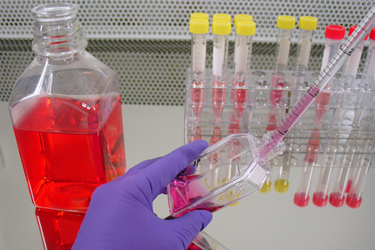Uncovering Cell Culture Media's Part In Latest Biopharma Trends
By Pooja Sharma, Global Market Insights

Cell culture media are specialized liquid or semi-solid formulations designed to nurture and sustain cell growth in a controlled setting. These solutions, abundant in nutrients like amino acids, vitamins, and growth factors, are pivotal for cellular functions, metabolism, and, ultimately, proliferation.
Cell culture media play a pivotal role in biopharmaceutical development, serving as a cornerstone for producing a range of biologics such as therapeutic proteins, monoclonal antibodies, vaccines, and cell-based therapies. These products are essential, creating an optimal environment for cell growth and productivity to facilitate large-scale production of critical biopharmaceuticals.
As the precise composition of cell culture media is tailored to meet the specific requirements of different cell types and applications, stakeholders can ensure consistent and reliable biopharmaceutical production. The COVID-19 pandemic further substantiated the importance of these formulations for vaccine and therapeutic development.
Global Market Insights Inc. (GMI), in a recent study, affirms that the cell culture media market size will register more than 12.8% CAGR over 2024-2032 in terms of revenue. This significant expansion underscores an increasing demand from various applications, including biopharmaceutical manufacturing and research.
Looking ahead, the industry scope revolves around an increased focus on personalized medicine, regenerative therapies, tissue engineering, and stem cell research.
Stem Cell Therapy Behind Media Demand Boost
Given the rising interest in stem cell therapies and their potential to transform treatments for various conditions, from neurodegenerative diseases to organ damage, the demand for top-tier stem cell culture media will surge. Innovative formulations that boost stem cell viability and function will define the market outlook.
The U.S. Centers for Disease Control and Prevention (CDC) says that neurodegenerative diseases affect approximately 5.8 million Americans, highlighting the urgent need for advanced treatments. Further, the European Commission stated that more than 27,000 organ transplants were performed in 2022, with more than 52,000 patients still on a waitlist. These statistics indicate a tremendous scope for advancing stem cell therapies and regenerative medicine over the coming years.
According to a study published in the International Journal of Oral Science, researchers discovered that human dental pulp stem cells (hDPSCs) can mitigate oxidative stress and improve neuroreparative effects in in-vitro Alzheimer's disease (AD) models. These stem cells help regulate hyperreactive microglia cells and repair damaged neurons. The findings propose hDPSCs as a promising candidate for Alzheimer's treatment, offering a feasible method to address the complex neuropathological environment associated with the disease.
Government support is also a major factor driving the segment, with increasing awareness about cell-based therapies. For instance, Theradaptive, Inc., a regenerative medicine company, secured $1 million in funding from the Maryland Stem Cell Research Fund to support human clinical trials for its lead product, OsteoAdapt SP. The biologic-enhanced implant aims to treat degenerative disc disease, spondylolisthesis, and retrolisthesis by stimulating precise local bone growth and promoting rapid spinal fusion.
Biopharma companies can leverage stem cell therapy advancements to develop more effective and personalized treatments. GMI reports that the stem cell culture media segment will be worth nearly $2 billion in 2024, demonstrating significant potential for investments.
Serum-free Cell Media Gain Traction
Historically, cell culture heavily relied on fetal bovine serum (FBS) for its potent mix of growth factors, hormones, and nutrients vital for cell growth and maintenance. Yet, the serum's drawbacks have spurred a quest for alternatives:
- Biological variability leads to inconsistent experimental outcomes and product quality, affecting cell growth and reproducibility.
- The ethical dilemmas and safety risks associated with animal-derived components, such as potential pathogen transmission, threaten cell line integrity and safety.
- Stringent regulations are in place for biopharmaceutical companies, pushing for reduced animal-derived inputs in production.
- Acquiring top-tier FBS comes with a hefty price tag and supply chain uncertainties.
Steering clear of the uncertainties linked with serum-based products, serum-free cell culture media are developed to establish a consistent and controlled environment. With precisely defined compositions, these media minimize batch-to-batch variations, ensuring more reliable experimental outcomes. Serum-free formulations can be fine-tuned to cater to the distinct needs of various cell types, from stem cells to recombinant lines. This customization can significantly boost cell viability, proliferation, and overall productivity.
By eradicating animal-derived elements, serum-free media not only reduce contamination risks but also adhere to ethical norms. This alignment with regulations accelerates the approval timelines for biopharmaceutical products. While the initial development of serum-free media might come with higher costs, the long-term advantages — such as reduced variability and improved scalability — far surpass these up-front expenses.
Modern tools like artificial intelligence (AI) and machine learning (ML) could prove to be instrumental in fueling cell culture media developments to meet emerging biomanufacturing needs. Citing an example, researchers at the University of Toronto are leveraging AI to craft serum-free cell culture media.
Through machine learning, the team can tailor media formulations to suit diverse cell types and their nutritional requirements. This breakthrough not only promises enhanced consistency but also paves the way for more scalable biomanufacturing processes.
Biopharma Applications Of Cell Culture Media
The GMI report suggests that biopharmaceutical applications could hold over 37% of the global cell culture media industry by 2032. Cell culture media will be critical in the mass production of biologics. These formulations are meticulously crafted, balancing nutrients, growth factors, and supplements to bolster proliferation, and protein expression. Such precision is key to achieving both high yields and unwavering quality standards.
Mammalian cell lines, notably Chinese hamster ovary (CHO) cells, are the go-to for expressing recombinant proteins and monoclonal antibodies. Given their demands, these cell lines necessitate specialized media formulations. CHO cells, which are used in over 70% of monoclonal antibody production, require media that support high-density cell cultures and maximize protein yield.
Cell culture media are essential in the production of gene therapies. Efficient production of viral vectors, produced using cell lines such as HEK293, requires tailored media to ensure high titers and functional integrity of the viral particles. Innovations in media composition can lead to improved transfection efficiencies and higher yields, making gene therapies more accessible and cost-effective.
Moreover, the biopharmaceutical industry is witnessing a rapid adoption of single-use bioreactors, which require specialized cell culture media formulations. These bioreactors offer advantages such as reduced risk of contamination and lower capital costs. Cell culture media designed for single-use systems must support high cell densities and maintain stability over extended culture periods, ensuring consistent product quality.
Conclusion
The rising demand for biopharmaceuticals, expanding applications in regenerative medicine, and continuous advancements in media formulation techniques are set to drive the cell culture media market growth. There is a consistent surge in the prevalence of chronic diseases and a shift toward personalized medicine. Moreover, the expanding role of these products, from stem cell research to tissue engineering, presents a vast landscape for biomanufacturers and CMOs.
Industry stakeholders who can navigate regulatory complexities, manage supply chain issues, and adapt to pricing pressures will be well positioned to capitalize on the burgeoning opportunities in this dynamic sector. Strategic collaborations and partnerships among key industry players could foster innovation and streamline production processes.
Investments in research and development will likely yield new and improved media formulations, while the integration of artificial intelligence and automation in manufacturing processes can offer greater efficiency and precision. The significance of chemically defined and animal-free media formulations will underline the market stance going forward.
 About The Author:
About The Author:
Pooja Sharma is a writer at Global Market Insights who writes about technology, healthcare, and chemical sectors.
